|
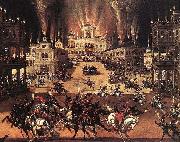 |
Claude Deruet
|
|
(1588-1660) was a famous French Baroque painter of the 17th century, from the city of Nancy.
Deruet was an apprentice to Jacques Bellange, the official court painter to Charles III, Duke of Lorraine. He was in Rome between ca. 1612 and 1619, where - according to Andre Felibien - he studied with the painter and etcher Antonio Tempesta. During his stay in Rome, he painted the Japanese samurai Hasekura Tsunenaga on a visit to Europe in 1615.
Deruet was made a noble by the Duke of Lorraine in 1621, and was then made a Knight of the Order of St Michel in 1645 by Louis XIII, who had in 1641 absorbed most of Lorraine into France. He had a luxurious residence in Nancy, named La Romaine, where Louis XIII and his Queen stayed in 1633.
Claude Lorrain was an apprentice to Claude Deruet in 1623 for one year. He also married and had two sons, one of whom became a painter.
|
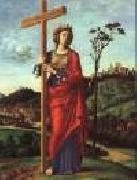 |
CIMA da Conegliano
|
|
Italian Painter, ca.1459-1517
Italian painter. He belonged to the generation between Giovanni Bellini and Giorgione and was one of the leading painters of early Renaissance Venice. His major works, several of which are signed, are almost all church altarpieces, usually depicting the Virgin and Child enthroned with saints; he also produced a large number of smaller half-length Madonnas. His autograph paintings are executed with great sensitivity and consummate craftsmanship. Fundamental to his artistic formation was the style that Bellini had evolved by the 1470s and 1480s; other important influences were Antonello da Messina and Alvise Vivarini. Although Cima was always capable of modest innovation, his style did not undergo any radical alteration during a career of some 30 years, and his response to the growing taste for Giorgionesque works from the early 16th century remained superficial. He seems to have maintained a sizeable workshop, |
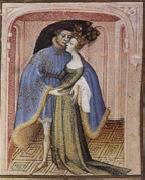 |
Christine de Pisan
|
|
French poet and arguably the first female author.
1364-1430
French writer. She was the daughter of an astrologer to Charles V and the wife of a court secretary and took up writing to support her children when she was widowed, producing 10 volumes of graceful verse, including ballads, rondeaux, lays, and complaints, many in the courtly-love tradition. Some works, both poetry and prose, champion women, notably The Book of the City of Ladies (1405). |
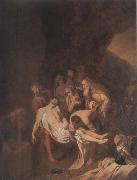 |
Christian Wilhelm Ernst Dietrich
|
|
German Painter, 1712-1774,German painter and etcher. He received his first training from his father, Johann Georg Dietrich (1684-1752), a court painter at Weimar, and was sent to Dresden at the age of 13 to study under the landscape painter Johann Alexander Thiele (1685-1752). In 1728 they travelled to Arnstadt to paint landscapes for stage sets. In 1730 Thiele presented his pupil to Frederick-Augustus I, Elector of Saxony, as a prodigy; Frederick-Augustus appointed him court painter and entrusted him to his minister Heinrich, Graf von Brehl, for whom he worked on some decorative paintings. From 1732 he used the name 'Dietricy' to sign his paintings. He travelled in Germany from 1734 and may have visited the Netherlands, the source of his artistic inspiration. He returned from his travels in 1741 and was appointed court painter to Frederick-Augustus II, Elector of Saxony, who sent him to Italy in 1743 to study. He visited Venice and Rome but returned to Dresden in 1744. |
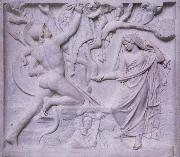 |
Christian Daniel Rauch
|
|
1777 Arolsen-1857 Dresden,was a German sculptor. Rauch was born at Arolsen in the Principality of Waldeck. His parents were poor and unable to place him under efficient masters. His first instructor taught him little else than the art of sculpting gravestones, and Professor Ruhl of Kassel could not give him much more. A wider field of improvement opened up before him when he removed to Berlin in 1797; but he was obliged to earn a livelihood by becoming a royal lackey, and to practise his art in spare hours. Queen Louisa of Prussia, surprising him one day in the act of modeling her features in wax, sent him to study at the Academy of Art. Not long afterwards, in 1804, Count Sandrecky gave Rauch the means to complete his education at Rome, where Wilhelm von Humboldt, Antonio Canova and Bertel Thorvaldsen befriended him. Among other works, he executed bas-reliefs of "Hippolytus and Phaedra," "Mars and Venus wounded by Diomede," and a "Child praying." In 1811 Rauch was commissioned to execute a monument for Queen Louisa of Prussia. |
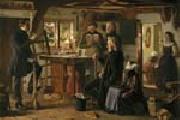 |
Christen Dalsgaard
|
|
(October 30, 1824-February 11, 1907), Danish painter, was born on the Krabbesholm estate on the fjord near Skive, and was son of the estate owner, Jens Dalsgaard.
|
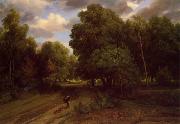 |
Charles-Francois Daubigny
|
|
French Barbizon School Painter, 1817-1878
was one of the painters of the Barbizon school, and is considered an important precursor of Impressionism. Daubigny was born into a family of painters and was taught the art by his father Edmond François Daubigny and his uncle, miniaturist Pierre Daubigny. Initially Daubigny painted in a traditional style, but this changed after 1843 when he settled in Barbizon to work outside in nature. Even more important was his meeting with Camille Corot in 1852 in Optevoz (Is??re). On his famous boat Botin, which he had turned into a studio, he painted along the Seine and Oise, often in the region around Auvers. From 1852 onward he came under the influence of Gustave Courbet. In 1866 Daubigny visited England, eventually returning because of the Franco-Prussian war in 1870. In London he met Claude Monet, and together they left for the Netherlands. Back in Auvers, he met Paul Cezanne, another important impressionist. |
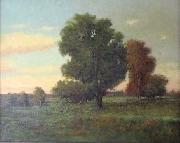 |
Charles S. Dorion
|
|
Charles was most likely born in Quebec, Canada, and moved to New York City sometime after 1880. He had a publishing company called C.S. Dorion, and was the 8th company to publish Edgar Allan Poe's the Raven, in New York in 1881.
PoliticsDuring the 1890s, Charles Dorian socialized with New York City's Social Democratic Party's elite, and used his quick tongue and self appointed crusading against injustice to help propel his friends political careers.
His first noted case was in the summer of 1893, when bucket shops were becoming a rampant problem in the city, as these "bucket shops" specializing in stocks and commodity futures, as the terms of trade were different for each bucket shop. |
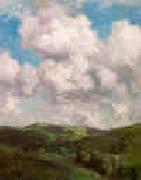 |
Charles Harold Davis
|
|
1856-1933
He was born at Amesbury, Massachusetts. A pupil of the schools of the Boston Museum of Fine Arts, he was sent to Paris in 1880. Having studied at the Acad??mie Julian under Jules Joseph Lefebvre and Gustave Boulanger, he went to Barbizon and painted much in the forest of Fontainebleau under the traditions of the men of thirty.
In 1890, Davis returned to the U.S., settling in Mystic, Connecticut. He shifted to Impressionism in his style, and took up the cloudscapes for which he became best-known. He eventually became a leading figure in the art colony that had developed in Mystic, and founded the Mystic Art Association in 1913.
He became a full member of the National Academy of Design in 1906, and received many awards, including a silver medal at the Paris Exhibition of 1889.
He is represented by important works in the Metropolitan Museum of Art, New York; the Corcoran Gallery of Art, Washington; the Pennsylvania Academy, Philadelphia, and the Boston Museum of Fine Arts. |
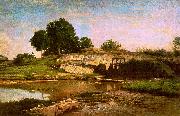 |
Charles Francois Daubigny
|
|
b Feb. 15, 1817, Paris, France
d.Feb. 19, 1878, Paris French
78, French landscape painter. He went to Italy early in life and later studied in Paris with Paul Delaroche. Although usually classed with the Barbizon school, he never lived in Barbizon. His last 30 years were spent largely in his houseboat on the Seine and the Oise, and he is best known for his pictures of the banks of those rivers. He was particularly successful in his atmospheric depiction of dawn, twilight, and moonlight. His later pictures are handled with great breadth. Monet and Boudin were especially attentive to his work. Daubigny is well represented in the Louvre, the Mesdag Museum (The Hague), the National Gallery (London), and the Metropolitan Museum. Characteristic are his Return of the Flock??Moonlight, Banks of the Oise, and Moonlight. His son Karl Pierre Daubigny, 1846?C86, painted in his father manner. |
 |
Charles Dixon
|
|
1872-1934. English painter, born in Goring-on-Thames in Oxfordshire on 8 December 1872 |
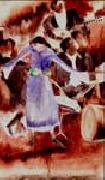 |
Charles Demuth
|
|
(November 8, 1883 - October 23, 1935) was an American watercolorist who turned to oils late in his career, developing a style of painting known as Precisionism.
"Search the history of American art," wrote Ken Johnson in the New York Times, "and you will discover few watercolors more beautiful than those of Charles Demuth. Combining exacting botanical observation and loosely Cubist abstraction, his watercolors of flowers, fruit and vegetables have a magical liveliness and an almost shocking sensuousness."
Demuth was a lifelong resident of Lancaster, Pennsylvania. The home he shared with his mother is now a museum of his work. He graduated from Franklin & Marshall Academy before studying at Drexel University and at Philadelphia's Pennsylvania Academy of Fine Arts. |
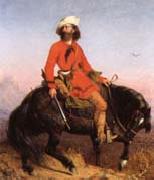 |
Charles Deas
|
|
1818-1867,American painter. After an unsuccessful attempt to obtain an appointment at West Point Military Academy, he turned to an artistic career. He quickly earned recognition at the annual exhibitions of the National Academy of Design, New York, to which he was elected an associate member in 1839, with subjects taken from James Fenimore Cooper, such as the Turkey Shoot (c. 1837; Richmond, VA Mus. F.A.), and from Washington Irving, The Devil and Tom Walker (1838; Richard P. W. Williams priv. col.). |
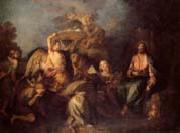 |
Charles de Lafosse
|
|
French Baroque Era Painter ,
Paris 1636/40 -1716
French painter and draughtsman. He was the most important decorative painter in France in the generation after Charles Le Brun and in this capacity contributed to many of the major official and private building projects from the 1670s to the 1710s, including the D?me des Invalides in Paris and the chapel at the ch?teau of Versailles. His colourist's temperament, his early study of the Venetian painters of the 16th century and his interest in the work of Peter Paul Rubens contributed to the triumph of the party that championed colour over line and put him in the vanguard of the new tendency in French painting in the later 17th century. His work, with its rich and changing colours, combines the strength of the 17th century with the lightness and grace of the 18th |
 |
Charles de La Fosse
|
|
(June 16, 1636 - December 13, 1716), French painter, was born in Paris.
He was one of the most noted and least servile pupils of Le Brun, under whose direction he shared in the chief of the great decorative works undertaken in the reign of Louis XIV. Leaving France in 1662, he spent two years in Rome and three in Venice. The influence of his prolonged studies of Veronese is evident in his "Finding of Moses" (Louvre), an in his "Rape of Proserpine" (Louvre), which he presented to the Royal Academy as his diploma picture in 1673. He was at once named assistant professor, and in 1674 the full responsibilities of the office devolved on him, but his engagements did not prevent his accepting in 1689 the invitation of Lord Montagu to decorate Montagu House.
He visited London twice, remaining on the second occasionetogether with Rousseau and Monnoyer more than two years. William III vainly strove to detain him in England by the proposal that he should decorate Hampton Court, for Le Brun was dead, and Mansart pressed La Fosse to return to Paris to take in hand the cupola of Les Invalides. The decorations of Montagu House are destroyed, those of Versailles are restored, and the dome of the Invalides (engraved, Picart and Cochin) is now the only work existing which gives a full measure of his talent. During his latter years La Fosse executed many other important decorations in public buildings and private houses, notably in that of Crozat, under whose roof he died on 13 December 1716.
This article incorporates text from a publication now in the public domain: Chisholm, Hugh, ed (1911). Encyclopædia Britannica (11th ed.). Cambridge University Press.
|
 |
charles de brosses
|
|
(1709-77). President of the Parlement de Dijon, friend of the philosophes, and in Diderot's words ??une petite t??te gaie, ironique et satiriquee. His learned publications include important work on the origins of language (Traite de la formation m??canique des langues, 1765) and on primitive religion (Du culte des dieux fetiches, 1760). His Lettres familieres crites d Italie en 1739 et 1740, published posthumously in 1799 and much loved by Stendhal, offer a model of personal travel writing, in which detailed accounts of art works and monuments, not always complimentary, or a careful description of Vesuvius, addressed to Buffon, are interspersed with sprightly, enthusiastic accounts of the peculiarities and the aesthetic and sensual pleasures of life in Italy.
|
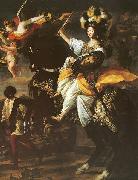 |
Charles Dauphin
|
|
Charles Claude Dauphin or Dofin, called in Italian Delfino, a French painter of historical subjects and portraits, was the son of Olivier Dauphin. He went to Turin about the year 1664, and worked there for the Prince of Carignano. He was also employed for the churches, but his works are in no great estimation, abounding as they do with the most ridiculous absurdities. In the church of San Carlo is an altar-piece by him, described by Lanzi as a most ludicrous composition. He died in 1677. |
 |
Charles Altamont Doyle
|
|
1832-1893
was a Victorian artist. He was the brother of the artist Richard Doyle, and the son of the artist John Doyle. Although the family was Irish, Doyle was born and raised in England. In 1849 he moved to Edinburgh where he met Mary Foley. They were married on 31 July 1855. Their children included Arthur Conan Doyle, creator of Sherlock Holmes, John Francis Innes Hay Doyle (known as Innes or Duff), and Jane Adelaide Rose Foley n??e Doyle (known as Ida). Doyle was not as successful an artist as he wished, and suffered depression and alcoholism. His paintings, which were generally of fairies, such as "A Dance Around The Moon", or similar fantasy scenes, reflected this, becoming more macabre over time. In 1881 Doyle was committed to a nursing home specialising in alcoholism. While there, his depression grew worse, and he began suffering epileptic seizures. Following a violent escape attempt he was sent to Sunnyside, Montrose Royal Lunatic Asylum, where he continued to paint. He died in Crighton Royal Institution in 1893. |
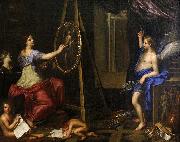 |
Charles Alphonse du Fresnoy
|
|
(1611C1665), French painter and writer on his art, was born in Paris, son of an apothecary.
He was destined for the medical profession, and well educated in Latin and Greek; but, having a natural propensity for the fine arts, he would not apply to his intended vocation, and was allowed to learn the rudiments of design under Perrier and Vouet. At the age of twenty-one he went off to Rome, with no resources; he drew ruins and architectural subjects.
After two years thus spent he re-encountered his old fellow-student Pierre Mignard, and by his aid obtained some amelioration of his professional prospects. He studied Raphael and the antique, went in 1633 to Venice, and in 1656 returned to France. During two years he was now employed in painting altar-pieces in the château du Raincy, landscapes, etc. His death was caused by an attack of apoplexy followed by palsy; he expired at Villiers-le-Bel, near Paris. He never married.
His pictorial works are few; they are correct in drawing, with something of the Caracci in design, and of Titian in colouring, but wanting fire and expression, and insufficient to keep his name in any eminent repute.
He is remembered now almost entirely as a writer rather than painter. His Latin poem, De arte graphica, was written during his Italian sojourn, and embodied his observations on the art of painting; it may be termed a critical treatise on the practice of the art, with general advice to students. The precepts are sound according to the standard of his time; the poetical merits slender enough. The Latin style is formed chiefly on Lucretius and Horace. |
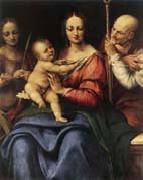 |
Cesare da Sesto
|
|
Italian High Renaissance Painter, 1477-1523, He was an Italian painter of the Renaissance active in Milan and elsewhere in Italy. He was born in Sesto Calende, Lombardy. He is considered one of the Leonardeschi or artists influenced by Leonardo da Vinci, such as Bernardino Luini and Marco D'Oggione. He may have trained or worked with Baldassare Peruzzi in Rome in 1505. Of this period, a lunette in Sant'Onofrio and some paintings in Campagnano Romano are attributed to him. From 1514 he soujourned in Naples for six years. In 1515 he finished a monumental polyptych for the Abbey of Santissima Trinita at Cava de' Tirreni. Back in Milan, he executed a Baptism of Christ, in collaboration with Bernardino Bernazzano (now lost) and a Salome, acquired by Rudolf II and now at the Kunsthistorisches Museum of Vienna. |
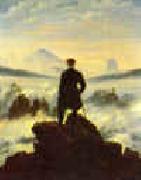 |
Caspar David Friedrich
|
|
1774-1840 Caspar David Friedrich Locations German painter, studied art at Copenhagen, and in 1798 settled in Dresden. Friedrich painted chiefly landscapes and seascapes, with and without figures, architectural pictures, including a few of Dresden, and some religious subjects. Religious feeling and symbolism permeate his œuvre, of which the seascape with figures, Die Lebensstufen, is a characteristic example. He possessed considerable power to convey mood in landscape. Almost forgotten in the 19th c. and early 20th c., interest in his work increased considerably in the mid-20th c. He is hardly represented in Britain, but an exhibition of 112 of his pictures at the Tate Gallery in 1972 attracted much attention. F. G. Kersting was a friend of Friedrich. |
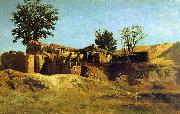 |
Carlos de Haes
|
|
Spanish
1826-1898
Carlos de Haes Galleries
Spanish painter of Belgian birth. In 1835 he moved with his parents to M?laga, where he studied under the court portrait painter and miniature painter Luis de la Cruz y R?os (1776-1853). In 1850 he returned to Belgium and studied with the landscape painter Joseph Quineaux (1822-95). During his studies there and on his travels in France, Germany and Holland, he became acquainted with contemporary Realist trends. He returned to Spain in 1855, becoming a naturalized Spaniard, and the following year he exhibited numerous landscapes at the Exposici?n Nacional, Madrid, to much acclaim. In 1857 he won the competition for the fourth chair of landscape painting at the Escuela de Bellas Artes in Madrid with View of the Royal Palace from the Casa de Campo (1857; Madrid, Real Acad. S Fernando), a work showing characteristics of the Barbizon and Fontainebleau landscape schools. In 1860 he was elected Acad?mico de m?rito at the Real Academia de S Fernando in Madrid. By 1861 he was officiating and drawing up the regulations for the landscape competitions for aspiring pensionnaires. Consequently plein-air works came to be required in place of the previous tradition of submitting historical landscapes executed in the studio, a practice that discouraged the study of nature. De Haes suggested that only final corrections should be made in the studio, an attitude that indicates his timid initiation and acceptance of Realist trends. |
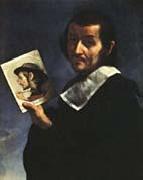 |
Carlo Dolci
|
|
Italian Baroque Era Painter, 1616-ca.1686
was an Italian painter of the Baroque period, active mainly in Florence, known for highly finished religious pictures, often repeated in many versions. He was born in Florence, on his mother's side the grandson of a painter. Although he was precocious and apprenticed at a young age to Jacopo Vignali, Dolci was not prolific. "He would take weeks over a single foot", according to his biographer Baldinucci. His painstaking technique made him unsuited for large-scale fresco painting. He painted chiefly sacred subjects, and his works are generally small in scale, although he made a few life-size pictures. He often repeated the same composition in several versions, and his daughter, Agnese Dolci, also made excellent copies of his works. Dolci was known for his piety. It is said that every year during Passion Week he painted a half-figure of the Saviour wearing the Crown of Thorns. In 1682, when he saw Giordano, nicknamed "fa presto" (quick worker), paint more in five hours than he could have completed in months, |
 |
Carlo Dolci
|
|
1616-1686
Italian
Carlo Dolci Locations
Italian painter. The major Florentine painter of the 17th century, he enjoyed an international reputation in his own lifetime. He was a gifted portrait painter and painted a number of large altarpieces, but his reputation is largely based on his half-length, single-figure paintings, characterized by their intense religiosity and meticulous technique. His mature style was complex and sophisticated. Intended for cultivated and aristocratic circles, his was never a popular art in any sense. Baldinucci described the painter tormented fantasy and dark fantasms, and his disturbed personality is evident throughout his work after the later 1640s. |
 |
Carl d Unker
|
|
(3 February 1828 - 23 June 1866)was a Swedish artist. He was mostly known as a socially oriented genre painter whose works were contemporary subjects of his time, like waiting rooms at railway stations, and scenes from pawnshops for example.
D'Unkers father was a Norwegian military, his mother Swedish. He began his career as a military and had served at the Svea Life Guards for a short time, when he in 1848 volunteered in the First Schleswig War 1848-1849. Shortly after his return to Sweden he abandoned his military path and went to the arts. He moved to Desseldorf to study painting, there he got married to a wealthy Russian woman and could live a carefree life financially. He became a very popular artist on the continent. From 1861 he suffered from sickness in his right arm so he had to paint with his left arm. He made a brief visit to Sweden in 1865, and was appointed professor by Swedish king Charles XV. The following year he died. |
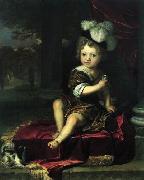 |
Carel de Moor
|
|
(February 25, 1655 - February 16, 1738) was a Dutch Golden Age etcher and painter. He was a pupil of Gerard Dou.
Carel de Moor was born in Leiden. According to Houbraken, his father was an art dealer who wanted him to study languages and only allowed him to study art when his talent for drawing surfaced at a young age. Houbraken met him in person at the atelier of Godfried Schalcken when he was completing his education there. According to the RKD he was the son of a Leiden painter of the same name and a pupil of Dou, Frans van Mieris, Godfried Schalcken, and Abraham van den Tempel. He became a member of the Leiden Guild of St. Luke in 1683, and became deacon many times over in the years 1688-1711. His own pupils later were Pieter Lyonet, Andrei Matveev, Arent Pijl, Arnout Rentinck, and Mattheus Verheyden.
|
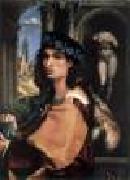 |
CAPRIOLO, Domenico
|
|
Italian painter, Venetian school (b. 1494, Venezia, d. 1528, Treviso)
Italian painter. He moved from Venice to Treviso c. 1517, where he is well documented (though there is little about his painting). In 1518-19 he married Camilla, daughter of the painter Pier Maria Pennacchi. A coherent body of work executed between 1518 and 1528 has been reconstructed. Capriolo's first secure work, the Adoration of the Shepherds (Treviso, Mus. Civ.), signed and dated 1518, has a formal structure reminiscent of the late style of Giovanni Bellini, with the broader chromatic range of Palma Vecchio and a crepuscular light that recalls the Venetian works of Giovanni Girolamo Savoldo or Giovanni da Asola ( fl 1512-31). The Assumption in Treviso Cathedral, commissioned in 1520, shows, in its spiralling movement, the influence of the contemporary frescoes of Pordenone in the nearby Malchiostro Chapel. In the Legend of the Doubting Midwife (Treviso, Mus. Civ.), signed and dated 1524, the influence of Savoldo is greater than that of Palma. This is also apparent in the altarpiece of the parish church of Ponzano Veneto (Treviso), dated 1525. The portrait of Lelio Torelli (Barnard Castle, Bowes Mus.), signed and dated 1528, Capriolo's last known work, seems by contrast to reflect local models of portraiture and lies somewhere between the styles of Sebastiano Florigerio and Bernardino Licinio. Other works assigned to Capriolo include: the altarpieces of the parish churches of Cavasagra and Spercenigo, near Treviso; the Adoration of the Shepherds in the sacristy of Serravalle Cathedral at Vittorio Veneto; a fragment of a Nativity (Venice, Mus. Correr); two paintings of the Virgin and Child with Saints (Bucharest, Mus. A.; Conegliano, Mus. Civ. Castello). |
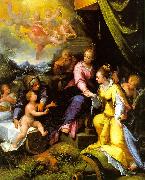 |
Calvaert, Denys
|
|
Flemish, 1540-1619
Flemish painter and draughtsman, active in Italy. In 1556-7 he was inscribed in the registers of the painters' corporation in Antwerp as a pupil of the landscape painter Kerstiaen van Queboorn (1515-78). Calvaert went to Bologna c. 1560, where he was to remain for the rest of his life. There he came under the protection of the influential Bolognini family and entered the workshop of Prospero Fontana the elder. After about two years he left Fontana to work with Lorenzo Sabatini, with whom he collaborated on several pictures, including the Holy Family with the Archangel St Michael (Bologna, S Giacomo Maggiore) and an Assumption (Bologna, Pin. N.). Calvaert's oeuvre is composed almost exclusively of religious works, ranging in size from vast altarpieces to small devotional pictures on copper. This sets him apart from other Netherlandish painters, notably those of the school of Prague, for whom Classical mythology was a constant source of inspiration. His first signed and dated work was Vigilance (1568; Bologna, Pin. N.); thereafter he developed a more original style, as in the Noli me tangere (Bologna, Pin. N.). |
 |
c. a. dahlstrom
|
|
Carl Petter Dahlström, född ca 1705, död 4 mars 1794, var en svensk möbelsnickare. Dahlström gesällvandrade 1745?C1755 i Nordeuropa och Frankrike, där han i Paris kom i lära hos den tidens främste ebenist Jean-François Oeben. Hos denne lärde sig Dahlström faneringstekniken marqueterie ?? fleurs eller blomsterintarsia, som var en metod för att möta rokokons krav på fanering av dubbelvälvda kroppar. Mycket tack vare rekommendationer av C.J. Cronstedt blev Dahlström efter hemkomsten till Sverige utnämnd till kunglig ebenist den 19 november 1756. Han finns representerad på Nationalmuseum med en byrå som han tillverkade tillsammans med Lorentz Nordin. Dahlström överlämnade 1769 sina privilegier till Niclas Palmgren och ägnade sig därefter åt restaurangverksamhet. |
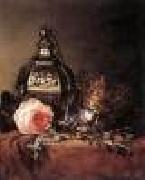 |
BRAY, Dirck
|
|
Dutch painter, Haarlem school (active 1651-1678) |
|

